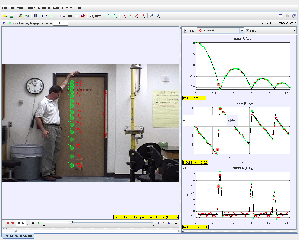

About
ball bounce model
For Teachers
- balldropbounce4x.mp4
- balldropbounce4x.avi
- balldropbounce4x.html
- .DS_Store
Software Requirements
| Android | iOS | Windows | MacOS | |
| with best with | no | no | need Java |
need Java |
| support full-screen? | no | no | Yes | Yes |
| cannot work on | no mobile browser understand Java.... |
no mobile browser understand Java.... | install Tracker from http://physlets.org/tracker/ |
install Tracker from http://physlets.org/tracker/ |
Credits
Author: video: byran model: lookang
Contact: This email address is being protected from spambots. You need JavaScript enabled to view it.
end faq
Computational Thinking
-
Students observe the motion of a bouncing ball and are challenged to describe its motion.
-
Students take a video of the actual motion of the bouncing ball (concrete representation) and analyse its motion using more abstract representations such as motion diagrams and graphs, with the aid of the Tracker software (see Fig. 1 and Fig. 2)).
-
Students explain the motion of the bouncing ball by drawing conceptual links between motion, force (with the aid of free- body diagrams) and energy.
Extension: students use a computer simulation ( http://iwant2study.org/lookangejss/02_newtonianmechanic s_2kinematics/ejss_model_freefall01/freefall01_Simulation. xhtml ) to consolidate, apply and extend their learning for different scenarios, with particular focus on the mathematical representation of motion (e.g. modelling motion with and without air resistance).
-
Computational thinking data practices (e.g. collecting, manipulating, analysing and visualising/representing data) and modelling motion of objects mathematically
-
Students experience translating a physical phenomenon in its concrete representation (i.e. data in the form of actual videos of moving objects) to more abstract graphical forms. They learn the importance of calibration, choice of reference point and explicating data frame-by-frame that allows for valid and useful analysis. In doing so, students better understand how the various representations relate to kinematics concepts (e.g. displacement, velocity and acceleration).
-
Students learn to interpret the given representations and to translate between different representations, and to assess the strengths and weaknesses of different representations.
end faq
Testimonials (0)
There are no testimonials available for viewing. Login to deploy the article and be the first to submit your review!
You have to login first to see this stats.
- Details
- Parent Category: 02 Newtonian Mechanics
- Category: 01 Kinematics
- Hits: 3328